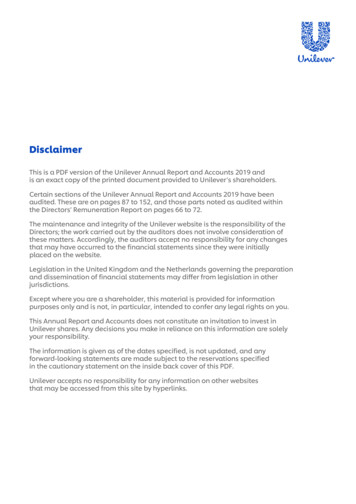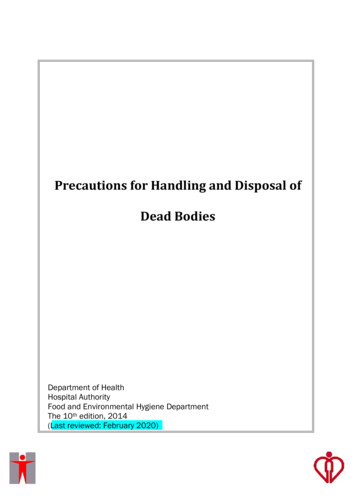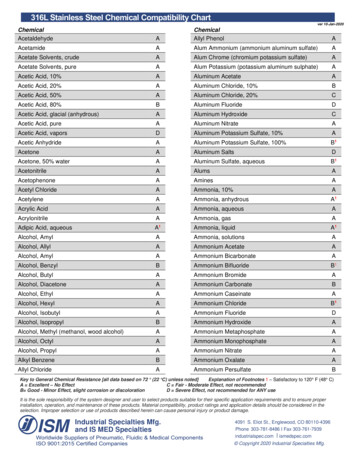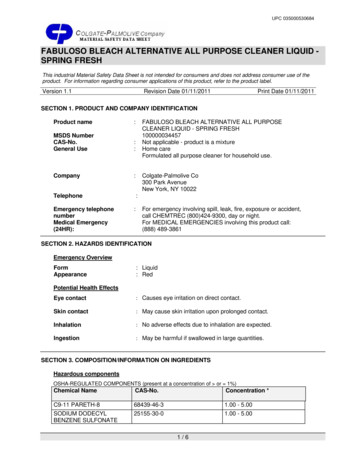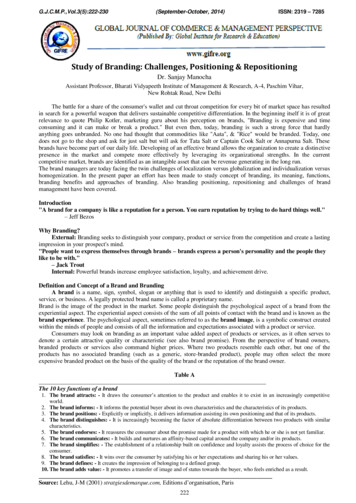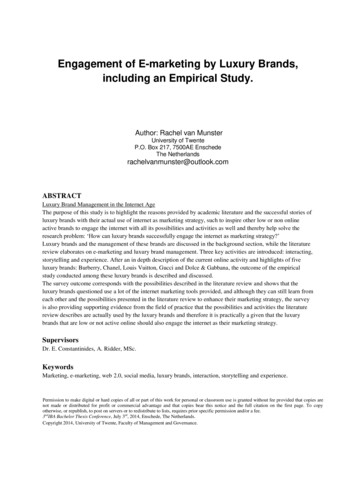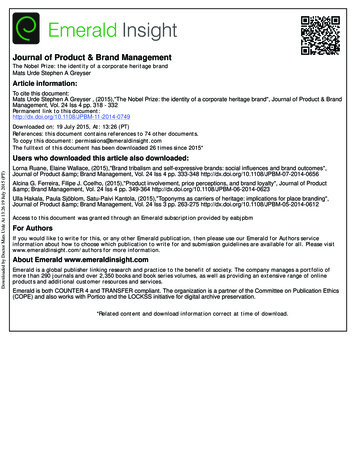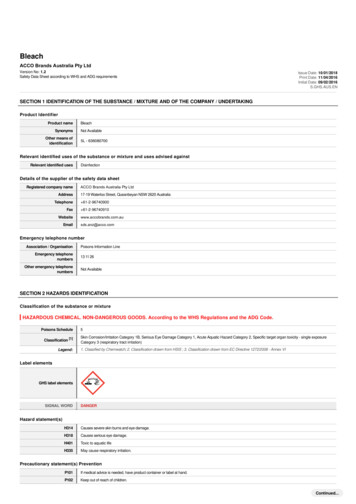
Transcription
BleachACCO Brands Australia Pty LtdVersion No: 1.2Safety Data Sheet according to WHS and ADG requirementsIssue Date: 10/01/2018Print Date: 11/04/2016Initial Date: 09/02/2016S.GHS.AUS.ENSECTION 1 IDENTIFICATION OF THE SUBSTANCE / MIXTURE AND OF THE COMPANY / UNDERTAKINGProduct IdentifierProduct nameSynonymsOther means ofidentificationBleachNot Available5L - 636080700Relevant identified uses of the substance or mixture and uses advised againstRelevant identified usesDisinfectionDetails of the supplier of the safety data sheetRegistered company nameAddressTelephoneFaxWebsiteEmailACCO Brands Australia Pty Ltd17-19 Waterloo Street, Queanbeyan NSW 2620 Australia 61-2-96740900 Emergency telephone numberAssociation / OrganisationEmergency telephonenumbersOther emergency telephonenumbersPoisons Information Line13 11 26Not AvailableSECTION 2 HAZARDS IDENTIFICATIONClassification of the substance or mixtureHAZARDOUS CHEMICAL. NON-DANGEROUS GOODS. According to the WHS Regulations and the ADG Code.Poisons ScheduleClassification[1]Legend:5Skin Corrosion/Irritation Category 1B, Serious Eye Damage Category 1, Acute Aquatic Hazard Category 2, Specific target organ toxicity - single exposureCategory 3 (respiratory tract irritation)1. Classified by Chemwatch; 2. Classification drawn from HSIS ; 3. Classification drawn from EC Directive 1272/2008 - Annex VILabel elementsGHS label elementsSIGNAL WORDDANGERHazard statement(s)H314Causes severe skin burns and eye damage.H318Causes serious eye damage.H401Toxic to aquatic lifeH335May cause respiratory irritation.Precautionary statement(s) PreventionP101If medical advice is needed, have product container or label at hand.P102Keep out of reach of children.Continued.
Issue Date: 10/01/2018Page 2 of 8Version No: 1.2Print Date: 11/04/2016BleachP103Read label before use.P260Do not breathe dust/fume/gas/mist/vapours/spray.P271Use only outdoors or in a well-ventilated area.P280Wear protective gloves/protective clothing/eye protection/face protection.P273Avoid release to the environment.Precautionary statement(s) ResponseP301 P330 P331IF SWALLOWED: Rinse mouth. Do NOT induce vomiting.P303 P361 P353IF ON SKIN (or hair): Remove/Take off immediately all contaminated clothing. Rinse skin with water/shower.P305 P351 P338IF IN EYES: Rinse cautiously with water for several minutes. Remove contact lenses, if present and easy to do. Continue rinsing.P310Immediately call a POISON CENTER or doctor/physician.P363Wash contaminated clothing before reuse.P304 P340IF INHALED: Remove victim to fresh air and keep at rest in a position comfortable for breathing.Precautionary statement(s) StorageP405P403 P233Store locked up.Store in a well-ventilated place. Keep container tightly closed.Precautionary statement(s) DisposalP501Dispose of contents/container in accordance with local regulations.SECTION 3 COMPOSITION / INFORMATION ON INGREDIENTSSubstancesSee section below for composition of MixturesMixturesCAS No%[weight]Name7681-52-9 10sodium hypochlorite1310-73-2 10sodium hydroxideSECTION 4 FIRST AID MEASURESDescription of first aid measuresEye ContactSkin ContactIf this product comes in contact with the eyes:Immediately hold eyelids apart and flush the eye continuously with running water.Ensure complete irrigation of the eye by keeping eyelids apart and away from eye and moving the eyelids by occasionally lifting the upper and lower lids.Continue flushing until advised to stop by the Poisons Information Centre or a doctor, or for at least 15 minutes.Transport to hospital or doctor without delay.Removal of contact lenses after an eye injury should only be undertaken by skilled personnel.If skin or hair contact occurs:Immediately flush body and clothes with large amounts of water, using safety shower if available.Quickly remove all contaminated clothing, including footwear.Wash skin and hair with running water. Continue flushing with water until advised to stop by the Poisons Information Centre.Transport to hospital, or doctor.InhalationIf fumes or combustion products are inhaled remove from contaminated area.Lay patient down. Keep warm and rested.Prostheses such as false teeth, which may block airway, should be removed, where possible, prior to initiating first aid procedures.Apply artificial respiration if not breathing, preferably with a demand valve resuscitator, bag-valve mask device, or pocket mask as trained. Perform CPR ifnecessary.Transport to hospital, or doctor, without delay.IngestionFor advice, contact a Poisons Information Centre or a doctor at once.Urgent hospital treatment is likely to be needed.If swallowed do NOT induce vomiting.If vomiting occurs, lean patient forward or place on left side (head-down position, if possible) to maintain open airway and prevent aspiration.Observe the patient carefully.Never give liquid to a person showing signs of being sleepy or with reduced awareness; i.e. becoming unconscious.Give water to rinse out mouth, then provide liquid slowly and as much as casualty can comfortably drink.Transport to hospital or doctor without delay.Indication of any immediate medical attention and special treatment neededTreat symptomatically.For acute or short-term repeated exposures to highly alkaline materials:Respiratory stress is uncommon but present occasionally because of soft tissue edema.Unless endotracheal intubation can be accomplished under direct vision, cricothyroidotomy or tracheotomy may be necessary.Oxygen is given as indicated.The presence of shock suggests perforation and mandates an intravenous line and fluid administration.Damage due to alkaline corrosives occurs by liquefaction necrosis whereby the saponification of fats and solubilisation of proteins allow deep penetration into the tissue.Alkalis continue to cause damage after exposure.INGESTION:Continued.
Page 3 of 8Version No: 1.2BleachIssue Date: 10/01/2018Print Date: 11/04/2016Milk and water are the preferred diluentsNo more than 2 glasses of water should be given to an adult.Neutralising agents should never be given since exothermic heat reaction may compound injury.* Catharsis and emesis are absolutely contra-indicated.* Activated charcoal does not absorb alkali.* Gastric lavage should not be used.Supportive care involves the following:Withhold oral feedings initially.If endoscopy confirms transmucosal injury start steroids only within the first 48 hours.Carefully evaluate the amount of tissue necrosis before assessing the need for surgical intervention.Patients should be instructed to seek medical attention whenever they develop difficulty in swallowing (dysphagia).SKIN AND EYE:Injury should be irrigated for 20-30 minutes.Eye injuries require saline. [Ellenhorn & Barceloux: Medical Toxicology]SECTION 5 FIREFIGHTING MEASURESExtinguishing mediaThere is no restriction on the type of extinguisher which may be used.Use extinguishing media suitable for surrounding area.Special hazards arising from the substrate or mixtureFire IncompatibilityNone known.Advice for firefightersAlert Fire Brigade and tell them location and nature of hazard.Wear breathing apparatus plus protective gloves in the event of a fire.Prevent, by any means available, spillage from entering drains or water courses.Use fire fighting procedures suitable for surrounding area.DO NOT approach containers suspected to be hot.Cool fire exposed containers with water spray from a protected location.If safe to do so, remove containers from path of fire.Equipment should be thoroughly decontaminated after use.Fire FightingFire/Explosion HazardNon combustible.Not considered a significant fire risk, however containers may burn.May emit poisonous fumes.May emit corrosive fumes.SECTION 6 ACCIDENTAL RELEASE MEASURESPersonal precautions, protective equipment and emergency proceduresMinor SpillsClean up all spills immediately.Avoid breathing vapours and contact with skin and eyes.Control personal contact with the substance, by using protective equipment.Contain and absorb spill with sand, earth, inert material or vermiculite.Wipe up.Place in a suitable, labelled container for waste disposal.Major SpillsModerate hazard.Clear area of personnel and move upwind.Alert Fire Brigade and tell them location and nature of hazard.Wear breathing apparatus plus protective gloves.Prevent, by any means available, spillage from entering drains or water course.Stop leak if safe to do so.Contain spill with sand, earth or vermiculite.Collect recoverable product into labelled containers for recycling.Personal Protective Equipment advice is contained in Section 8 of the SDS.SECTION 7 HANDLING AND STORAGEPrecautions for safe handlingSafe handlingAvoid all personal contact, including inhalation.Wear protective clothing when risk of exposure occurs.Use in a well-ventilated area.Prevent concentration in hollows and sumps.DO NOT enter confined spaces until atmosphere has been checked.DO NOT allow material to contact humans, exposed food or food utensils.Avoid contact with incompatible materials.When handling, DO NOT eat, drink or smoke.Other informationConditions for safe storage, including any incompatibilitiesSuitable containerStorage incompatibilityPolyethylene or polypropylene container.Packing as recommended by manufacturer.Check all containers are clearly labelled and free from leaks.Avoid contact with copper, aluminium and their alloys.Avoid strong acids, acid chlorides, acid anhydrides and chloroformates.Continued.
Issue Date: 10/01/2018Page 4 of 8Version No: 1.2Print Date: 11/04/2016BleachSECTION 8 EXPOSURE CONTROLS / PERSONAL PROTECTIONControl parametersOCCUPATIONAL EXPOSURE LIMITS (OEL)INGREDIENT DATASourceIngredientMaterial nameTWASTELPeakNotesAustralia Exposure Standardssodium hydroxideSodium hydroxideNot AvailableNot Available2 mg/m3Not AvailableEMERGENCY LIMITSIngredientMaterial nameTEEL-1TEEL-2TEEL-3sodium hypochloriteSodium hypochlorite pentahydrate4.6 mg/m351 mg/m3290 mg/m3sodium hypochloriteSodium hypochlorite2 mg/m320 mg/m3630 mg/m3sodium hydroxideSodium hydroxideNot AvailableNot AvailableNot AvailableIngredientOriginal IDLHsodium hypochloriteNot AvailableNot Availablesodium hydroxide250 mg/m310 mg/m3Revised IDLHExposure controlsAppropriate engineeringcontrolsEngineering controls are used to remove a hazard or place a barrier between the worker and the hazard. Well-designed engineering controls can be highlyeffective in protecting workers and will typically be independent of worker interactions to provide this high level of protection.The basic types of engineering controls are:Process controls which involve changing the way a job activity or process is done to reduce the risk.Enclosure and/or isolation of emission source which keeps a selected hazard "physically" away from the worker and ventilation that strategically "adds" and"removes" air in the work environment. Ventilation can remove or dilute an air contaminant if designed properly. The design of a ventilation system must matchthe particular process and chemical or contaminant in use.Employers may need to use multiple types of controls to prevent employee overexposure.Local exhaust ventilation usually required.Personal protectionEye and face protectionSkin protectionHands/feet protectionSafety glasses with unperforated side shields may be used where continuous eye protection is desirable, as in laboratories; spectacles are not sufficientwhere complete eye protection is needed such as when handling bulk-quantities, where there is a danger of splashing, or if the material may be underpressure.Chemical goggles.whenever there is a danger of the material coming in contact with the eyes; goggles must be properly fitted.Full face shield (20 cm, 8 in minimum) may be required for supplementary but never for primary protection of eyes; these afford face protection.Alternatively a gas mask may replace splash goggles and face shields.Contact lenses may pose a special hazard; soft contact lenses may absorb and concentrate irritants. A written policy document, describing the wearing oflenses or restrictions on use, should be created for each workplace or task. This should include a review of lens absorption and adsorption for the class ofchemicals in use and an account of injury experience. Medical and first-aid personnel should be trained in their removal and suitable equipment should bereadily available.See Hand protection belowElbow length PVC glovesWhen handling corrosive liquids, wear trousers or overalls outside of boots, to avoid spills entering boots.Body protectionSee Other protection belowOther protectionOveralls.P.V.C. apron.Barrier cream.Skin cleansing cream.Eye wash unit.Thermal hazardsNot AvailableRespiratory protectionRecommended material(s)GLOVE SELECTION INDEXGlove selection is based on a modified presentation of the:"Forsberg Clothing Performance Index".The effect(s) of the following substance(s) are taken into account in the computergenerated selection:BleachType B-P Filter of sufficient capacity. (AS/NZS 1716 & 1715, EN 143:2000 & 149:2001, ANSIZ88 or national equivalent)Where the concentration of gas/particulates in the breathing zone, approaches or exceeds the"Exposure Standard" (or ES), respiratory protection is required.Degree of protection varies with both face-piece and Class of filter; the nature of protectionvaries with Type of filter.MaterialCPINEOPRENEARequired MinimumProtection d AirRespiratorBUTYLCup to 10 x ESB-AUS P2-NAT NEOPR NITRILECB-PAPR-AUS /Class 1 P2NATURAL RUBBERCup to 50 x ES-B-AUS / Class 1P2-NATURAL NEOPRENECup to 100 x ES-B-2 P2B-PAPR-2 P2 NEOPRENE/NATURALC - Full-faceContinued.
Issue Date: 10/01/2018Page 5 of 8Version No: 1.2Print Date: 11/04/2016BleachNITRILECNITRILE PVCCPECPE/EVAL/PECPVACPVCCSARANEX-23CSARANEX-23 2-PLYCTEFLONCVITONCVITON/CHLOROBUTYLCA(All classes) Organic vapours, B AUS or B1 Acid gasses, B2 Acid gas or hydrogencyanide(HCN), B3 Acid gas or hydrogen cyanide(HCN), E Sulfur dioxide(SO2), G Agricultural chemicals, K Ammonia(NH3), Hg Mercury, NO Oxides of nitrogen, MB Methyl bromide, AX Low boiling point organic compounds(below 65 degC)* CPI - Chemwatch Performance IndexA: Best SelectionB: Satisfactory; may degrade after 4 hours continuous immersionC: Poor to Dangerous Choice for other than short term immersionNOTE: As a series of factors will influence the actual performance of the glove, a finalselection must be based on detailed observation. * Where the glove is to be used on a short term, casual or infrequent basis, factors such as"feel" or convenience (e.g. disposability), may dictate a choice of gloves which might otherwisebe unsuitable following long-term or frequent use. A qualified practitioner should be consulted.SECTION 9 PHYSICAL AND CHEMICAL PROPERTIESInformation on basic physical and chemical propertiesAppearancePhysical stateYellow liquidLiquidRelative density (Water 1)1.00-1.05OdourNot AvailablePartition coefficientn-octanol / waterOdour thresholdNot AvailableAuto-ignition temperature( C)Not AvailablepH (as supplied)11-13DecompositiontemperatureNot AvailableNot AvailableMelting point / freezingpoint ( C)Not AvailableViscosity (cSt)Not AvailableInitial boiling point andboiling range ( C)Not AvailableMolecular weight (g/mol)Not AvailableFlash point ( C)Not AvailableTasteNot AvailableEvaporation rateNot AvailableExplosive propertiesNot AvailableFlammabilityNot AvailableOxidising propertiesNot AvailableUpper Explosive Limit (%)Not AvailableSurface Tension (dyn/cm ormN/m)Not AvailableLower Explosive Limit (%)Not AvailableVolatile Component (%vol)Not AvailableVapour pressure (kPa)Not AvailableGas groupSolubility in water (g/L)MiscibleVapour density (Air 1)Not AvailablepH as a solution (1%)VOC g/LNot Available9-110SECTION 10 STABILITY AND REACTIVITYReactivityChemical stabilitySee section 7Unstable in the presence of incompatible materials.Product is considered stable.Hazardous polymerisation will not occur.Possibility of hazardousreactionsSee section 7Conditions to avoidSee section 7Incompatible materialsSee section 7Hazardous decompositionproductsSee section 5SECTION 11 TOXICOLOGICAL INFORMATIONInformation on toxicological effectsInhaledThe material can cause respiratory irritation in some persons. The body's response to such irritation can cause further lung damage.Inhaling corrosive bases may irritate the respiratory tract. Symptoms include cough, choking, pain and damage to the mucous membrane.Not normally a hazard due to non-volatile nature of productThe material has NOT been classified by EC Directives or other classification systems as "harmful by inhalation". This is because of the lack of corroboratingContinued.
Issue Date: 10/01/2018Page 6 of 8Version No: 1.2Print Date: 11/04/2016Bleachanimal or human evidence.IngestionSkin ContactIngestion of alkaline corrosives may produce burns around the mouth, ulcerations and swellings of the mucous membranes, profuse saliva production, with aninability to speak or swallow. Both the oesophagus and stomach may experience burning pain; vomiting and diarrhoea may follow.The material has NOT been classified by EC Directives or other classification systems as "harmful by ingestion". This is because of the lack of corroboratinganimal or human evidence.The material can produce severe chemical burns following direct contact with the skin.Skin contact is not thought to have harmful health effects (as classified under EC Directives); the material may still produce health damage following entrythrough wounds, lesions or abrasions.Open cuts, abraded or irritated skin should not be exposed to this materialEntry into the blood-stream, through, for example, cuts, abrasions or lesions, may produce systemic injury with harmful effects. Examine the skin prior to the useof the material and ensure that any external damage is suitably protected.This material can cause inflammation of the skin on contact in some persons.EyeIf applied to the eyes, this material causes severe eye damage.Direct eye contact with corrosive bases can cause pain and burns. There may be swelling, epithelium destruction, clouding of the cornea and inflammation ofthe iris. Mild cases often resolve; severe cases can be prolonged with complications such as persistent swelling, scarring, permanent cloudiness, bulging ofthe eye, cataracts, eyelids glued to the eyeball and blindness.ChronicRepeated or prolonged exposure to corrosives may result in the erosion of teeth, inflammatory and ulcerative changes in the mouth and necrosis (rarely) of thejaw. Bronchial irritation, with cough, and frequent attacks of bronchial pneumonia may ensue.Long-term exposure to respiratory irritants may result in disease of the airways involving difficult breathing and related systemic problems.Substance accumulation, in the human body, may occur and may cause some concern following repeated or long-term occupational exposure.There has been some concern that this material can cause cancer or mutations but there is not enough data to make an assessment.TOXICITYIRRITATIONNot AvailableNot AvailableBleachTOXICITYIRRITATIONDermal (rabbit) LD50: 10000 mg/kg [1]Eye (rabbit): 10 mg - moderatesodium hypochloriteOral (rat) LD50: 237 mg/kg[1]Eye (rabbit): 100 mg - moderateSkin (rabbit): 500 mg/24h-moderateTOXICITYOral (rabbit) LD50: 325 mg/kgsodium hydroxideIRRITATION[1]Eye (rabbit): 0.05 mg/24h SEVEREEye (rabbit):1 mg/24h SEVEREEye (rabbit):1 mg/30s rinsed-SEVERESkin (rabbit): 500 mg/24h SEVERELegend:BleachSODIUM HYPOCHLORITE1. Value obtained from Europe ECHA Registered Substances - Acute toxicity 2.* Value obtained from manufacturer's SDS. Unless otherwise specified dataextracted from RTECS - Register of Toxic Effect of chemical SubstancesAsthma-like symptoms may continue for months or even years after exposure to the material ceases. This may be due to a non-allergenic condition known asreactive airways dysfunction syndrome (RADS) which can occur following exposure to high levels of highly irritating compound. Key criteria for the diagnosisof RADS include the absence of preceding respiratory disease, in a non-atopic individual, with abrupt onset of persistent asthma-like symptoms within minutesto hours of a documented exposure to the irritant. A reversible airflow pattern, on spirometry, with the presence of moderate to severe bronchial hyperreactivityon methacholine challenge testing and the lack of minimal lymphocytic inflammation, without eosinophilia, have also been included in the criteria for diagnosisof RADS. RADS (or asthma) following an irritating inhalation is an infrequent disorder with rates related to the concentration of and duration of exposure to theirritating substance. Industrial bronchitis, on the other hand, is a disorder that occurs as result of exposure due to high concentrations of irritating substance(often particulate in nature) and is completely reversible after exposure ceases. The disorder is characterised by dyspnea, cough and mucus production.Asthma-like symptoms may continue for months or even years after exposure to the material ceases. This may be due to a non-allergenic condition known asreactive airways dysfunction syndrome (RADS) which can occur following exposure to high levels of highly irritating compound. Key criteria for the diagnosisof RADS include the absence of preceding respiratory disease, in a non-atopic individual, with abrupt onset of persistent asthma-like symptoms within minutesto hours of a documented exposure to the irritant. A reversible airflow pattern, on spirometry, with the presence of moderate to severe bronchial hyperreactivityon methacholine challenge testing and the lack of minimal lymphocytic inflammation, without eosinophilia, have also been included in the criteria for diagnosisof RADS. RADS (or asthma) following an irritating inhalation is an infrequent disorder with rates related to the concentration of and duration of exposure to theirritating substance. Industrial bronchitis, on the other hand, is a disorder that occurs as result of exposure due to high concentrations of irritating substance(often particulate in nature) and is completely reversible after exposure ceases. The disorder is characterised by dyspnea, cough and mucus production.Hypochlorite salts are classified by IARC as Group 3: NOT classifiable as to its carcinogenicity to humans.Evidence of carcinogenicity may be inadequate or limited in animal testing.The material may produce moderate eye irritation leading to inflammation. Repeated or prolonged exposure to irritants may produce conjunctivitis.Hypochlorite salts are extremely corrosive and can cause severe damage to the eyes and skin. A number of skin cancers have been observed in mice, whenapplied to their skin.as sodium hypochlorite pentahydrateThe material may produce severe irritation to the eye causing pronounced inflammation. Repeated or prolonged exposure to irritants may produceconjunctivitis.The material may cause severe skin irritation after prolonged or repeated exposure and may produce on contact skin redness, swelling, the production ofvesicles, scaling and thickening of the skin. Repeated exposures may produce severe ulceration.SODIUM HYDROXIDEAsthma-like symptoms may continue for months or even years after exposure to the material ceases. This may be due to a non-allergenic condition known asreactive airways dysfunction syndrome (RADS) which can occur following exposure to high levels of highly irritating compound. Key criteria for the diagnosisof RADS include the absence of preceding respiratory disease, in a non-atopic individual, with abrupt onset of persistent asthma-like symptoms within minutesto hours of a documented exposure to the irritant. A reversible airflow pattern, on spirometry, with the presence of moderate to severe bronchial hyperreactivityon methacholine challenge testing and the lack of minimal lymphocytic inflammation, without eosinophilia, have also been included in the criteria for diagnosisContinued.
Issue Date: 10/01/2018Page 7 of 8Version No: 1.2Print Date: 11/04/2016Bleachof RADS. RADS (or asthma) following an irritating inhalation is an infrequent disorder with rates related to the concentration of and duration of exposure to theirritating substance. Industrial bronchitis, on the other hand, is a disorder that occurs as result of exposure due to high concentrations of irritating substance(often particulate in nature) and is completely reversible after exposure ceases. The disorder is characterised by dyspnea, cough and mucus production.Acute ToxicityCarcinogenicitySkin Irritation/CorrosionReproductivitySerious EyeDamage/IrritationSTOT - Single ExposureRespiratory or SkinsensitisationSTOT - Repeated ExposureMutagenicityAspiration HazardLegend:– Data available but does not fill the criteria for classification– Data required to make classification available– Data Not Available to make classificationSECTION 12 ECOLOGICAL INFORMATIONToxicityIngredientEndpointTest Duration (hr)SpeciesValueSourcesodium hypochloriteEC500.08Crustacea0.002mg/L4sodium hypochloriteLC5096Fish0.032mg/L4sodium hypochloriteEC5048Crustacea0.026mg/L2sodium hypochloriteEC5072Algae or other aquatic plants0.0183mg/L2sodium hypochloriteNOEC72Algae or other aquatic plants0.0054mg/L2sodium hydroxideEC50384Crustacea27901.643mg/L3sodium hydroxideEC5096Algae or other aquatic plants1034.10043mg/L3sodium hydroxideLC5096Fish4.16158mg/L3sodium hydroxideNOEC96Fish56mg/L4sodium hydroxideEC5048Crustacea40.4mg/L2Legend:Extracted from 1. IUCLID Toxicity Data 2. Europe ECHA Registered Substances - Ecotoxicological Information - Aquatic Toxicity 3. EPIWIN Suite V3.12 Aquatic Toxicity Data (Estimated) 4. US EPA, Ecotox database - Aquatic Toxicity Data 5. ECETOC Aquatic Hazard Assessment Data 6. NITE (Japan) Bioconcentration Data 7. METI (Japan) - Bioconcentration Data 8. Vendor DataDO NOT discharge into sewer or waterways.Persistence and degradabilityIngredientPersistence: Water/SoilPersistence: Airsodium hydroxideLOWLOWBioaccumulative potentialIngredientBioaccumulationsodium hydroxideLOW (LogKOW -3.8796)Mobility in soilIngredientMobilitysodium hydroxideLOW (KOC 14.3)SECTION 13 DISPOSAL CONSIDERATIONSWaste treatment methodsRecycle wherever possible.Consult manufacturer for recycling options or consult local or regional waste management authority for disposal if no suitable treatment or disposal facilitycan be identified.Treat and neutralise at an approved treatment plant.Treatment should involve: Neutralisation with suitable dilute acid followed by: burial in a land-fill specifically licenced to accept chemical and / orpharmaceutical wastes or Incineration in a licenced apparatus (after admixture with suitable combustible material).Decontaminate empty containers. Observe all label safeguards until containers are cleaned and destroyed.Product / PackagingdisposalSECTION 14 TRANSPORT INFORMATIONLabels RequiredMarine PollutantHAZCHEMNONot ApplicableLand transport (ADG): NOT REGULATED FOR TRANSPORT OF DANGEROUS GOODSContinued.
Issue Date: 10/01/2018Page 8 of 8Version No: 1.2Print Date: 11/04/2016BleachAir transport (ICAO-IATA / DGR): NOT REGULATED FOR TRANSPORT OF DANGEROUS GOODSSea transport (IMDG-Code / GGVSee): NOT REGULATED FOR TRANSPORT OF DANGEROUS GOODSTransport in bulk according to Annex II of MARPOL and the IBC codeNot ApplicableSECTION 15 REGULATORY INFORMATIONSafety, health and environmental regulations / legislation specific for the substance or mixtureSODIUM HYPOCHLORITE(7681-52-9) IS FOUND ON THE FOLLOWING REGULATORY LISTSAustralia Hazardous Substances Information System - Consolidated ListsAustralia Inventory of Chemical Substances (AICS)International Agency for Research on Cancer (IARC) - Agents Classified by the IARCMonographsSODIUM HYDROXIDE(1310-73-2) IS FOUND ON THE FOLLOWING REGULATORY LISTSAustralia Exposure StandardsAustralia Hazardous Substances Information System - Consolidated ListsNational InventoryStatusAustralia - AICSYCanada - DSLYCanada - NDSLN (sodium hypochlorite; sodium hydroxide)China - IECSCYEurope - EINEC / ELINCS /NLPYAustralia Inventory of Chemical Substances (AICS)Japan - ENCSYKorea - KECIYNew Zealand - NZIoCYPhilippines - PICCSYUSA - TSCAYLegend:Y All ingredients are on the inventoryN Not determined or one or more ingredients are not on the inventory and are not exempt from listing(see specific ingredients in brackets)SECTION 16 OTHER INFORMATIONOther informationIngredients with multiple cas numbersNameCAS Nosodium hypochlorite10022-70-5, 7681-52-9sodium hydroxide12200-64-5, 1310-73-2Classification of the preparation and its individual components has drawn on official and authoritative sources as well as independent review by the Chemwatch Classification committee usingavailable literature references.A list of reference resources used to assist the committee may be found at:www.chemwatch.netThe SDS is a Hazard Communication tool and should be used to assist in the Risk Assessment. Many factors determine whether the reported Hazards are Risks in the workplace or othersettings. Risks may be determined by reference to Exposures Scenarios. Scale of use, frequency of use and current or available engineering controls must be considered.Definitions and abbreviationsPC-TWA: Permissible Concentration-Time Weighted AveragePC-STEL: Permissible Concentration-Short Term Exposure LimitIARC: International Agency for Research on CancerACGIH: American Conference of Governmental Industrial HygienistsSTEL: Short Term Exposure LimitTEEL: Temporary Emergency Exposure Limit。IDLH: Immediately Dangerous to Life or Health ConcentrationsOSF: Odour Safety FactorNOAEL :No Observed Adverse Effect LevelLOAEL: Lowest Observed Adverse Effect LevelTLV: Threshold Limit ValueLOD: Limit Of DetectionOTV: Odour Threshold ValueBCF: BioConcentration FactorsBEI: Biological Exposure IndexThis document is copyright.Apart from any fair dealing for the purposes
Engineering controls are used to remove a hazard or place a barrier between the worker and the hazard. Well-designed engineering controls can be highly effective in protecting workers and will typically be independent of worker interactions to provide this high level of protection. The basic types of engineering controls are:
